SSANGYONG KORANDO 1997 Service Repair Manual
Manufacturer: SSANGYONG, Model Year: 1997, Model line: KORANDO, Model: SSANGYONG KORANDO 1997Pages: 2053, PDF Size: 88.33 MB
Page 921 of 2053
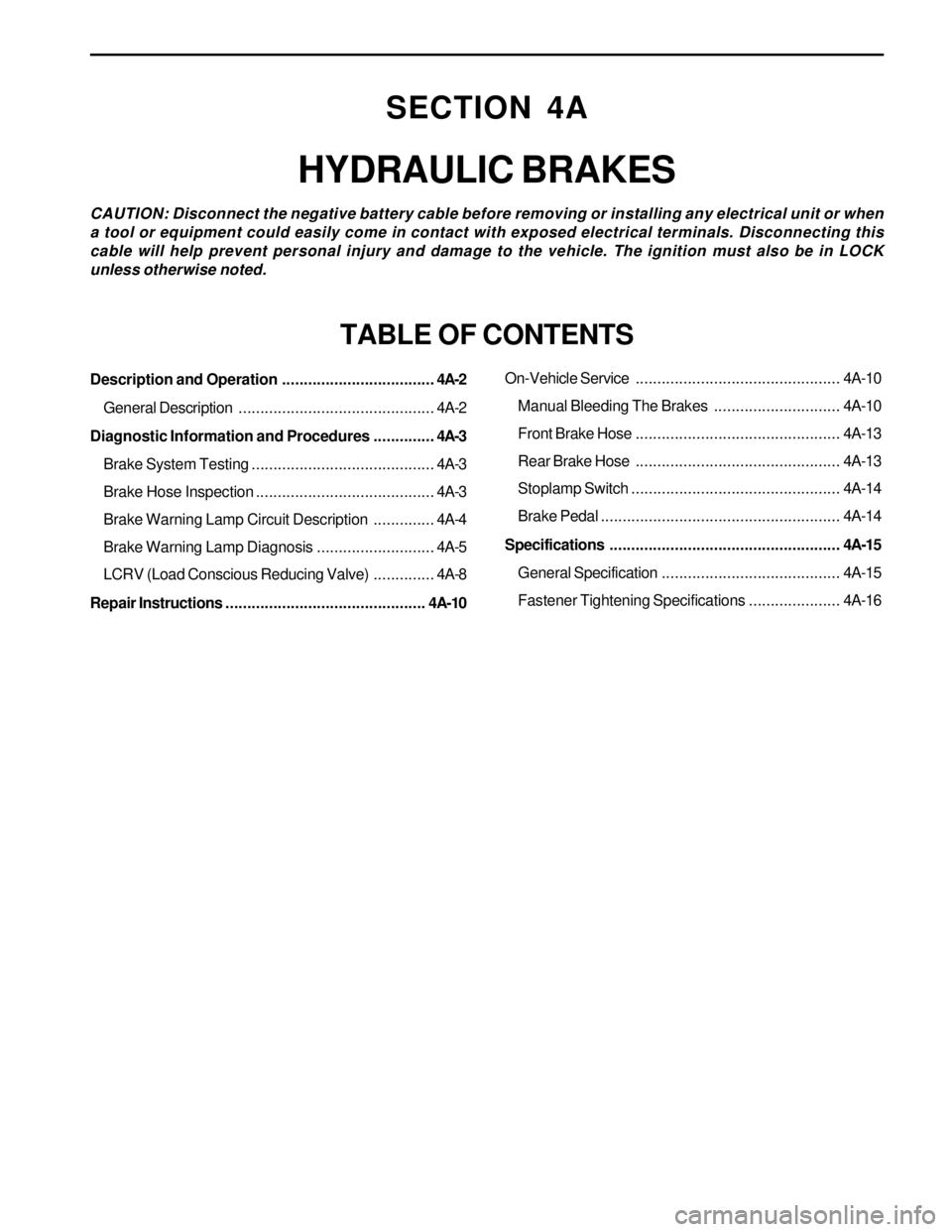
SECTION 4A
HYDRAULIC BRAKES
CAUTION: Disconnect the negative battery cable before removing or installing any electrical unit or when
a tool or equipment could easily come in contact with exposed electrical terminals. Disconnecting this
cable will help prevent personal injury and damage to the vehicle. The ignition must also be in LOCK
unless otherwise noted.
TABLE OF CONTENTS
Description and Operation...................................4A-2
General Description.............................................4A-2
Diagnostic Information and Procedures..............4A-3
Brake System Testing ..........................................4A-3
Brake Hose Inspection.........................................4A-3
Brake Warning Lamp Circuit Description..............4A-4
Brake Warning Lamp Diagnosis...........................4A-5
LCRV (Load Conscious Reducing Valve)..............4A-8
Repair Instructions..............................................4A-10On-Vehicle Service...............................................4A-10
Manual Bleeding The Brakes.............................4A-10
Front Brake Hose...............................................4A-13
Rear Brake Hose...............................................4A-13
Stoplamp Switch................................................4A-14
Brake Pedal.......................................................4A-14
Specifications.....................................................4A-15
General Specification .........................................4A-15
Fastener Tightening Specifications.....................4A-16
Page 922 of 2053

SSAMGYONG MY2002
4A-2 HYDRAULIC BRAKES
DESCRIPTION AND OPERATION
GENERAL DESCRIPTION
Brake fluid should meet the DOT 4 specification. Use
only clear fluid from a sealed container.
Fluid that is exposed to the air will absorb moisture.
Water in the brake fluid will cause the fluid to boil and
the rubber components to deteriorate.
Thoroughly clean the master cylinder reservoir cap be-
fore removing it. Do not let any dirt or foreign material
fall into the fluid reservoir.
There is a brake fluid level switch under the master
cylinder reservoir.When the fluid level is low, the BRAKE lamp in the
instrument cluster will turn on.
The correct brake fluid level is marked on the both
side of the brake fluid reservoir. If the fluid level is
below the MIN indicator mark, check the hydraulic brake
system for leaks. Fix any leaks. Then refill the reservoir
to the MAX indicator mark.
The hydraulic brake system is parallel split on Antilock
Brake Systems. This means the left front and left rear
brakes are on one hydraulic circuit and the right front
and right rear are on the other.
Page 923 of 2053
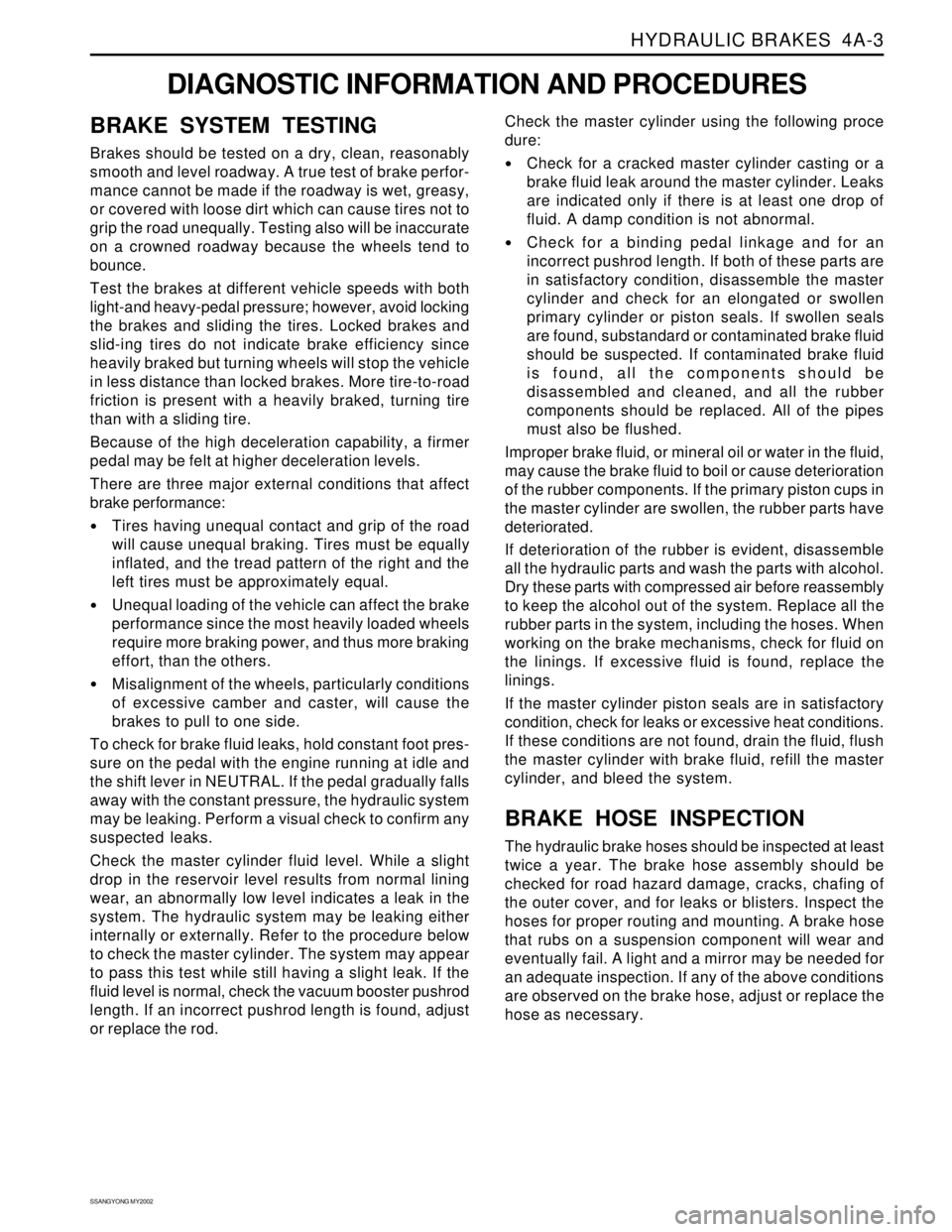
HYDRAULIC BRAKES 4A-3
SSANGYONG MY2002
DIAGNOSTIC INFORMATION AND PROCEDURES
BRAKE SYSTEM TESTING
Brakes should be tested on a dry, clean, reasonably
smooth and level roadway. A true test of brake perfor-
mance cannot be made if the roadway is wet, greasy,
or covered with loose dirt which can cause tires not to
grip the road unequally. Testing also will be inaccurate
on a crowned roadway because the wheels tend to
bounce.
Test the brakes at different vehicle speeds with both
light-and heavy-pedal pressure; however, avoid locking
the brakes and sliding the tires. Locked brakes and
slid-ing tires do not indicate brake efficiency since
heavily braked but turning wheels will stop the vehicle
in less distance than locked brakes. More tire-to-road
friction is present with a heavily braked, turning tire
than with a sliding tire.
Because of the high deceleration capability, a firmer
pedal may be felt at higher deceleration levels.
There are three major external conditions that affect
brake performance:
•Tires having unequal contact and grip of the road
will cause unequal braking. Tires must be equally
inflated, and the tread pattern of the right and the
left tires must be approximately equal.
Unequal loading of the vehicle can affect the brake
performance since the most heavily loaded wheels
require more braking power, and thus more braking
effort, than the others.
Misalignment of the wheels, particularly conditions
of excessive camber and caster, will cause the
brakes to pull to one side.
To check for brake fluid leaks, hold constant foot pres-
sure on the pedal with the engine running at idle and
the shift lever in NEUTRAL. If the pedal gradually falls
away with the constant pressure, the hydraulic system
may be leaking. Perform a visual check to confirm any
suspected leaks.
Check the master cylinder fluid level. While a slight
drop in the reservoir level results from normal lining
wear, an abnormally low level indicates a leak in the
system. The hydraulic system may be leaking either
internally or externally. Refer to the procedure below
to check the master cylinder. The system may appear
to pass this test while still having a slight leak. If the
fluid level is normal, check the vacuum booster pushrod
length. If an incorrect pushrod length is found, adjust
or replace the rod.Check the master cylinder using the following proce
dure:
Check for a cracked master cylinder casting or a
brake fluid leak around the master cylinder. Leaks
are indicated only if there is at least one drop of
fluid. A damp condition is not abnormal.
Check for a binding pedal linkage and for an
incorrect pushrod length. If both of these parts are
in satisfactory condition, disassemble the master
cylinder and check for an elongated or swollen
primary cylinder or piston seals. If swollen seals
are found, substandard or contaminated brake fluid
should be suspected. If contaminated brake fluid
is found, all the components should be
disassembled and cleaned, and all the rubber
components should be replaced. All of the pipes
must also be flushed.
Improper brake fluid, or mineral oil or water in the fluid,
may cause the brake fluid to boil or cause deterioration
of the rubber components. If the primary piston cups in
the master cylinder are swollen, the rubber parts have
deteriorated.
If deterioration of the rubber is evident, disassemble
all the hydraulic parts and wash the parts with alcohol.
Dry these parts with compressed air before reassembly
to keep the alcohol out of the system. Replace all the
rubber parts in the system, including the hoses. When
working on the brake mechanisms, check for fluid on
the linings. If excessive fluid is found, replace the
linings.
If the master cylinder piston seals are in satisfactory
condition, check for leaks or excessive heat conditions.
If these conditions are not found, drain the fluid, flush
the master cylinder with brake fluid, refill the master
cylinder, and bleed the system.
BRAKE HOSE INSPECTION
The hydraulic brake hoses should be inspected at least
twice a year. The brake hose assembly should be
checked for road hazard damage, cracks, chafing of
the outer cover, and for leaks or blisters. Inspect the
hoses for proper routing and mounting. A brake hose
that rubs on a suspension component will wear and
eventually fail. A light and a mirror may be needed for
an adequate inspection. If any of the above conditions
are observed on the brake hose, adjust or replace the
hose as necessary.
Page 924 of 2053

SSAMGYONG MY2002
4A-4 HYDRAULIC BRAKES
KAA4A010
BRAKE WARNING LAMP CIRCUIT DESCRIPTION
Diagnostic Aids
The BRAKE lamp glows brightly when the ignition is
ON and either the parking brake lever switch or the
brake fluid level switch is closed.
If neither switch is closed, the BRAKE lamp receives
a ground through the generator, and it glows dimly
when the ignition is ON and the engine is off. When
the engine starts, the generator creates voltage. With
voltage on both sides of the lamp, the lamp turns off.
Test Description
The numbers below refer to steps in the diagnostic
table.
1. This step begins the test sequence for a BRAKE
warning lamp that stays on when the engine is run-
ning.
2. This step begins the test sequence for a BRAKE
warning lamp that never turns on.
Page 925 of 2053
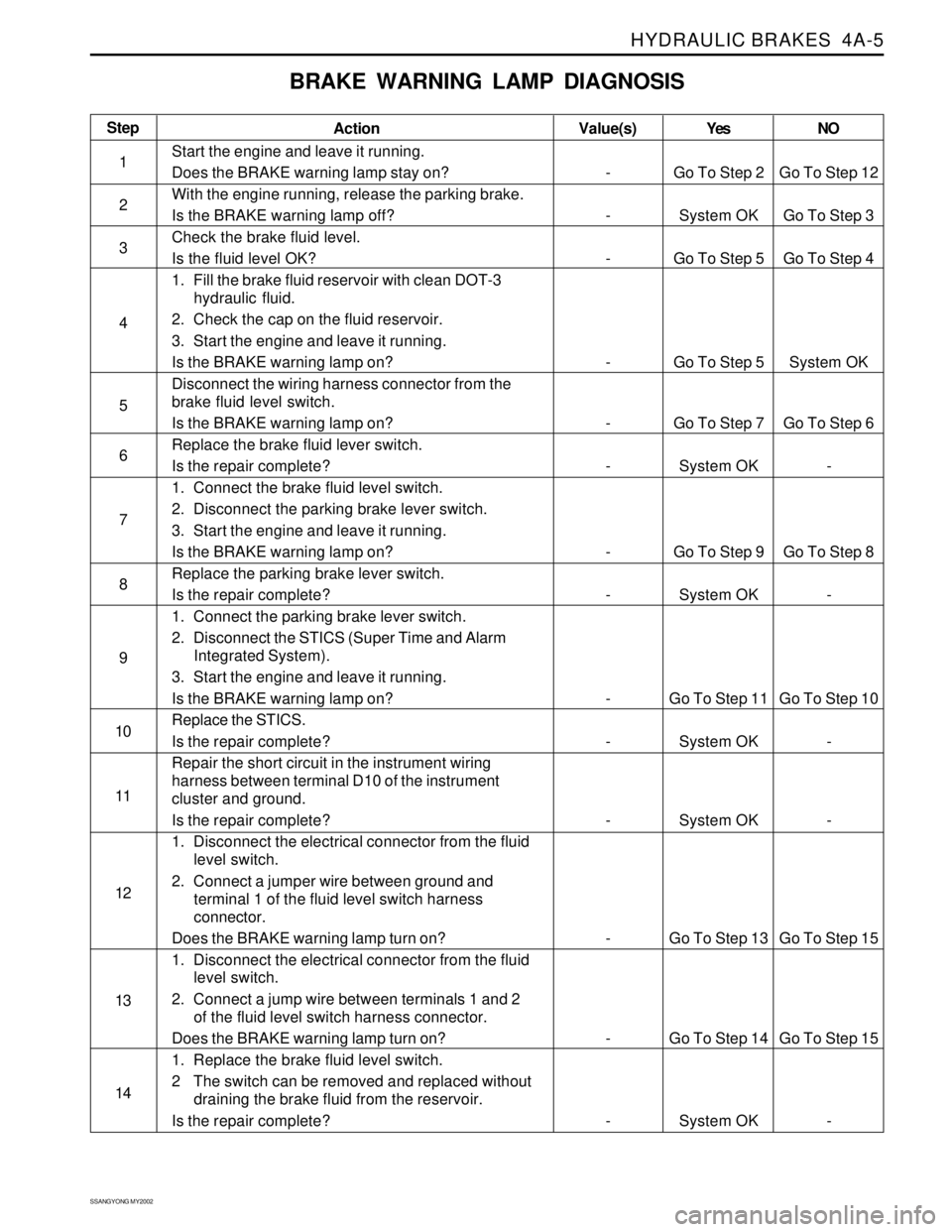
HYDRAULIC BRAKES 4A-5
SSANGYONG MY2002
Value(s)
-
-
-
-
-
-
-
-
-
-
-
-
-
-
BRAKE WARNING LAMP DIAGNOSIS
Step
1
2
3
4
5
6
7
8
9
10
11
12
13
14Action
Start the engine and leave it running.
Does the BRAKE warning lamp stay on?
With the engine running, release the parking brake.
Is the BRAKE warning lamp off?
Check the brake fluid level.
Is the fluid level OK?
1. Fill the brake fluid reservoir with clean DOT-3
hydraulic fluid.
2. Check the cap on the fluid reservoir.
3. Start the engine and leave it running.
Is the BRAKE warning lamp on?
Disconnect the wiring harness connector from the
brake fluid level switch.
Is the BRAKE warning lamp on?
Replace the brake fluid lever switch.
Is the repair complete?
1. Connect the brake fluid level switch.
2. Disconnect the parking brake lever switch.
3. Start the engine and leave it running.
Is the BRAKE warning lamp on?
Replace the parking brake lever switch.
Is the repair complete?
1. Connect the parking brake lever switch.
2. Disconnect the STICS (Super Time and Alarm
Integrated System).
3. Start the engine and leave it running.
Is the BRAKE warning lamp on?
Replace the STICS.
Is the repair complete?
Repair the short circuit in the instrument wiring
harness between terminal D10 of the instrument
cluster and ground.
Is the repair complete?
1. Disconnect the electrical connector from the fluid
level switch.
2. Connect a jumper wire between ground and
terminal 1 of the fluid level switch harness
connector.
Does the BRAKE warning lamp turn on?
1. Disconnect the electrical connector from the fluid
level switch.
2. Connect a jump wire between terminals 1 and 2
of the fluid level switch harness connector.
Does the BRAKE warning lamp turn on?
1. Replace the brake fluid level switch.
2 The switch can be removed and replaced without
draining the brake fluid from the reservoir.
Is the repair complete?Yes
Go To Step 2
System OK
Go To Step 5
Go To Step 5
Go To Step 7
System OK
Go To Step 9
System OK
Go To Step 11
System OK
System OK
Go To Step 13
Go To Step 14
System OKNO
Go To Step 12
Go To Step 3
Go To Step 4
System OK
Go To Step 6
-
Go To Step 8
-
Go To Step 10
-
-
Go To Step 15
Go To Step 15
-
Page 926 of 2053
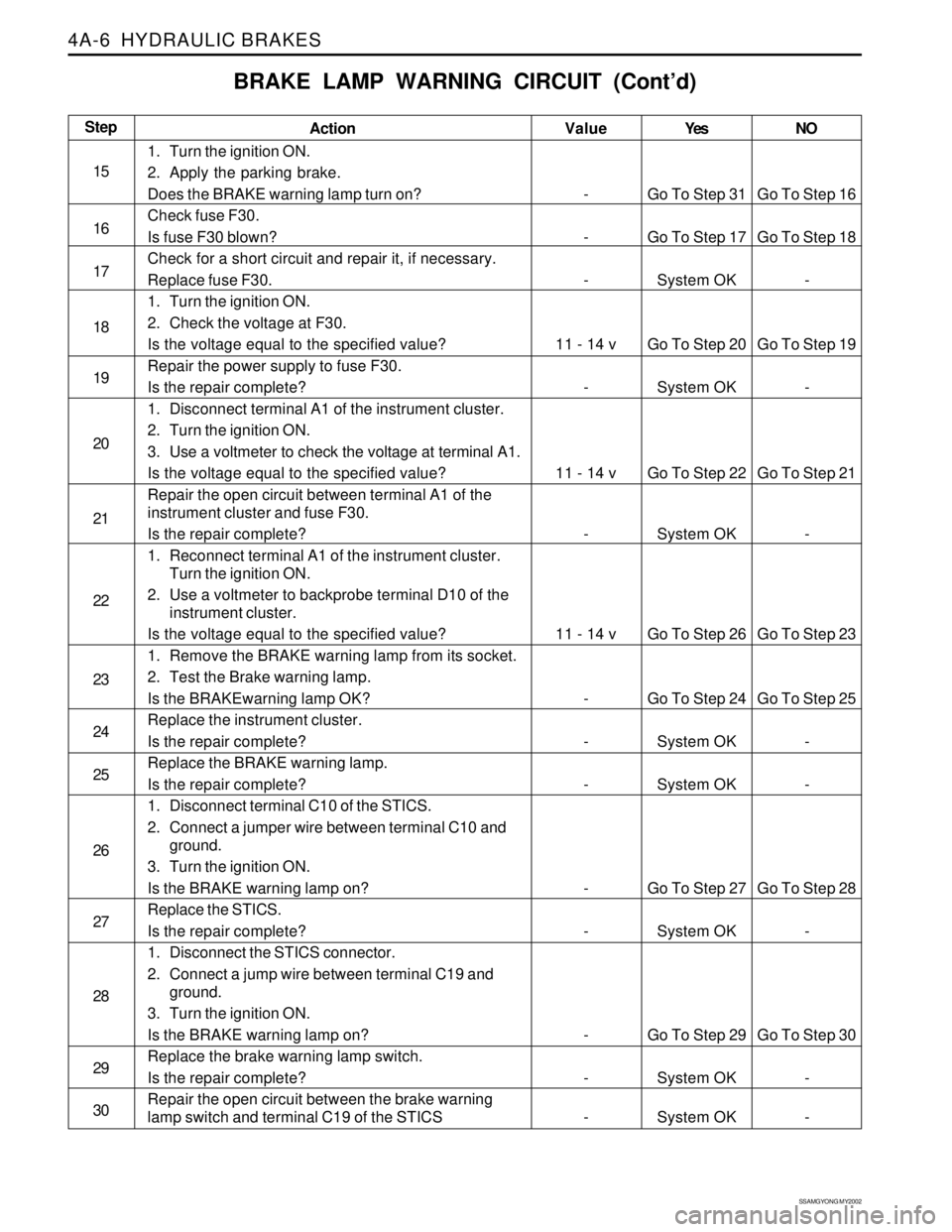
SSAMGYONG MY2002
4A-6 HYDRAULIC BRAKES
Action
1. Turn the ignition ON.
2. Apply the parking brake.
Does the BRAKE warning lamp turn on?
Check fuse F30.
Is fuse F30 blown?
Check for a short circuit and repair it, if necessary.
Replace fuse F30.
1. Turn the ignition ON.
2. Check the voltage at F30.
Is the voltage equal to the specified value?
Repair the power supply to fuse F30.
Is the repair complete?
1. Disconnect terminal A1 of the instrument cluster.
2. Turn the ignition ON.
3. Use a voltmeter to check the voltage at terminal A1.
Is the voltage equal to the specified value?
Repair the open circuit between terminal A1 of the
instrument cluster and fuse F30.
Is the repair complete?
1. Reconnect terminal A1 of the instrument cluster.
Turn the ignition ON.
2. Use a voltmeter to backprobe terminal D10 of the
instrument cluster.
Is the voltage equal to the specified value?
1. Remove the BRAKE warning lamp from its socket.
2. Test the Brake warning lamp.
Is the BRAKEwarning lamp OK?
Replace the instrument cluster.
Is the repair complete?
Replace the BRAKE warning lamp.
Is the repair complete?
1. Disconnect terminal C10 of the STICS.
2. Connect a jumper wire between terminal C10 and
ground.
3. Turn the ignition ON.
Is the BRAKE warning lamp on?
Replace the STICS.
Is the repair complete?
1. Disconnect the STICS connector.
2. Connect a jump wire between terminal C19 and
ground.
3. Turn the ignition ON.
Is the BRAKE warning lamp on?
Replace the brake warning lamp switch.
Is the repair complete?
Repair the open circuit between the brake warning
lamp switch and terminal C19 of the STICS
BRAKE LAMP WARNING CIRCUIT (Cont’d)
Yes
Go To Step 31
Go To Step 17
System OK
Go To Step 20
System OK
Go To Step 22
System OK
Go To Step 26
Go To Step 24
System OK
System OK
Go To Step 27
System OK
Go To Step 29
System OK
System OKNO
Go To Step 16
Go To Step 18
-
Go To Step 19
-
Go To Step 21
-
Go To Step 23
Go To Step 25
-
-
Go To Step 28
-
Go To Step 30
-
-Step
15
16
17
18
19
20
21
22
23
24
25
26
27
28
29
30Value
-
-
-
11 - 14 v
-
11 - 14 v
-
11 - 14 v
-
-
-
-
-
-
-
-
Page 927 of 2053

HYDRAULIC BRAKES 4A-7
SSANGYONG MY2002
BRAKE LAMP WARNING CIRCUIT (Cont’d)
Action
1. Disconnect the brake fluid level switch.
2. Use an ohmmeter to check the resistance between
terminal 2 of the switch connector and ground.
Is the resistance equal to the specified value?
Repair the open circuit between ground and the brake
fluid level switch.
Is the repair complete?
Repair the open circuit between terminal 1 of the brake
fluid level switch and terminal D10 of the instrument
cluster.
Is the repair complete?Yes
Go To Step 32
System OK
System OKNO
Go To Step 33
-
-Step
31
32
33Value(s)
≈ 0 Ω
-
-
Page 928 of 2053

SSAMGYONG MY2002
4A-8 HYDRAULIC BRAKES
YAD4A170
YAD4A180
LCRV (LOAD CONSCIOUS
REDUCING VALVE)
LCRV consists of sensing part and hydraulic control
part.
1. Sensing Part
It detects the changes of vehicle height caused
by vehicle load. It consists of load sensing spring
and control lever which change according to
vehicle load.
2. Hydraulic Control Part
It consists of valve stem devices which controls
hydraulic pressure according to load detected by
sensing part.
YAD4A190
4. Place alignment marks between the lock nut (b)
and adjusting screw (c) after the valve setting.
5. LCRV setting should be performed with unloaded
vehicle condition.
Setting Method
1. Install the connecting rod (a) to the No.1 hole.
2. Adjust the clearance “X” to be 0mm and tighten
the bolt (c) using the lock nut (b).
Installation Notice
Tightening Torque14 - 18 Nm
(10 - 13 lb-ft)
3. Remove the connecting rod (a) from the No.1 hole
and reinstall it to the No.2 hole.
Installation Notice
Tightening Torque14 - 18 Nm
(10 - 13 lb-ft)
Page 929 of 2053
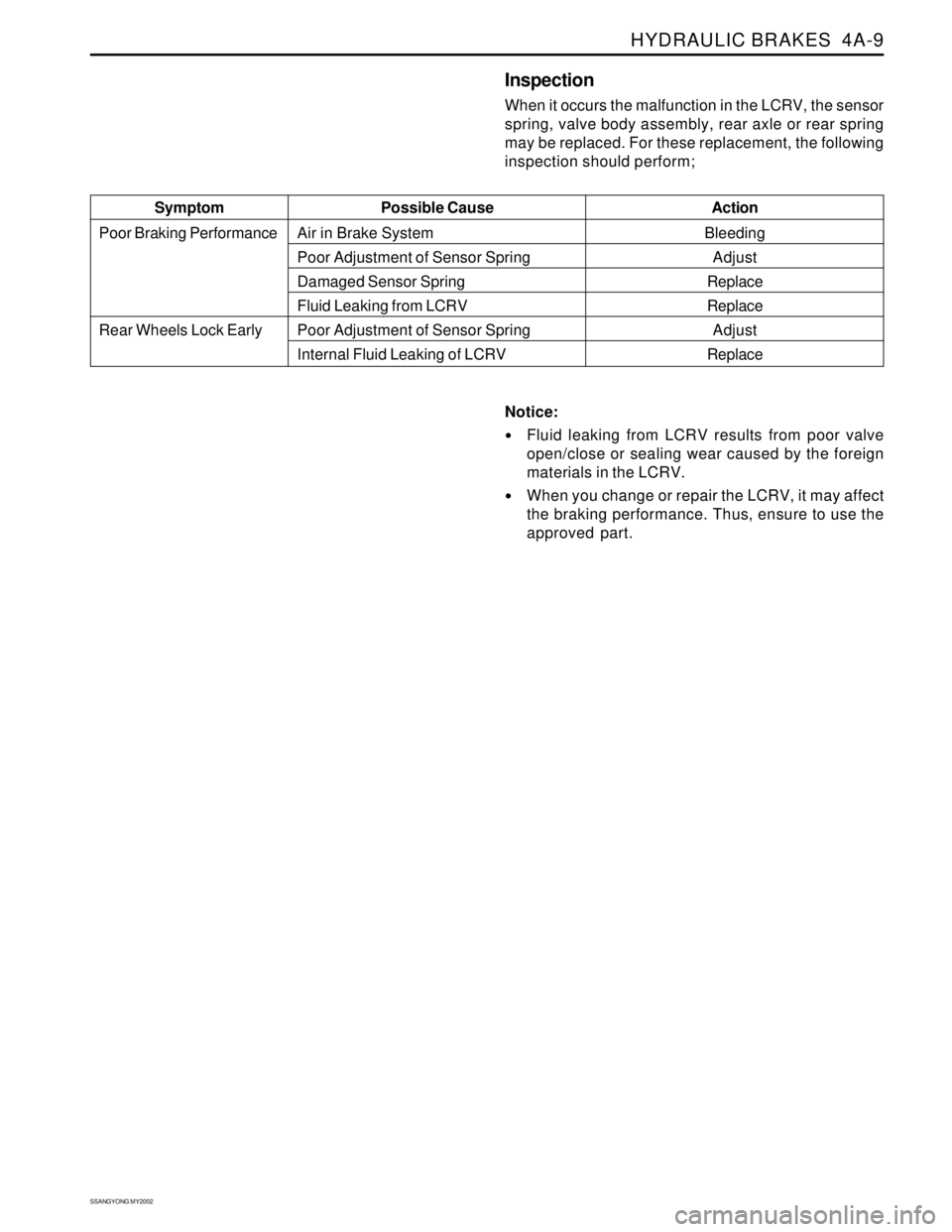
HYDRAULIC BRAKES 4A-9
SSANGYONG MY2002
Inspection
When it occurs the malfunction in the LCRV, the sensor
spring, valve body assembly, rear axle or rear spring
may be replaced. For these replacement, the following
inspection should perform;
Symptom
Poor Braking Performance
Rear Wheels Lock EarlyPossible Cause
Air in Brake System
Poor Adjustment of Sensor Spring
Damaged Sensor Spring
Fluid Leaking from LCRV
Poor Adjustment of Sensor Spring
Internal Fluid Leaking of LCRVAction
Bleeding
Adjust
Replace
Replace
Adjust
Replace
Notice:
Fluid leaking from LCRV results from poor valve
open/close or sealing wear caused by the foreign
materials in the LCRV.
When you change or repair the LCRV, it may affect
the braking performance. Thus, ensure to use the
approved part.
Page 930 of 2053
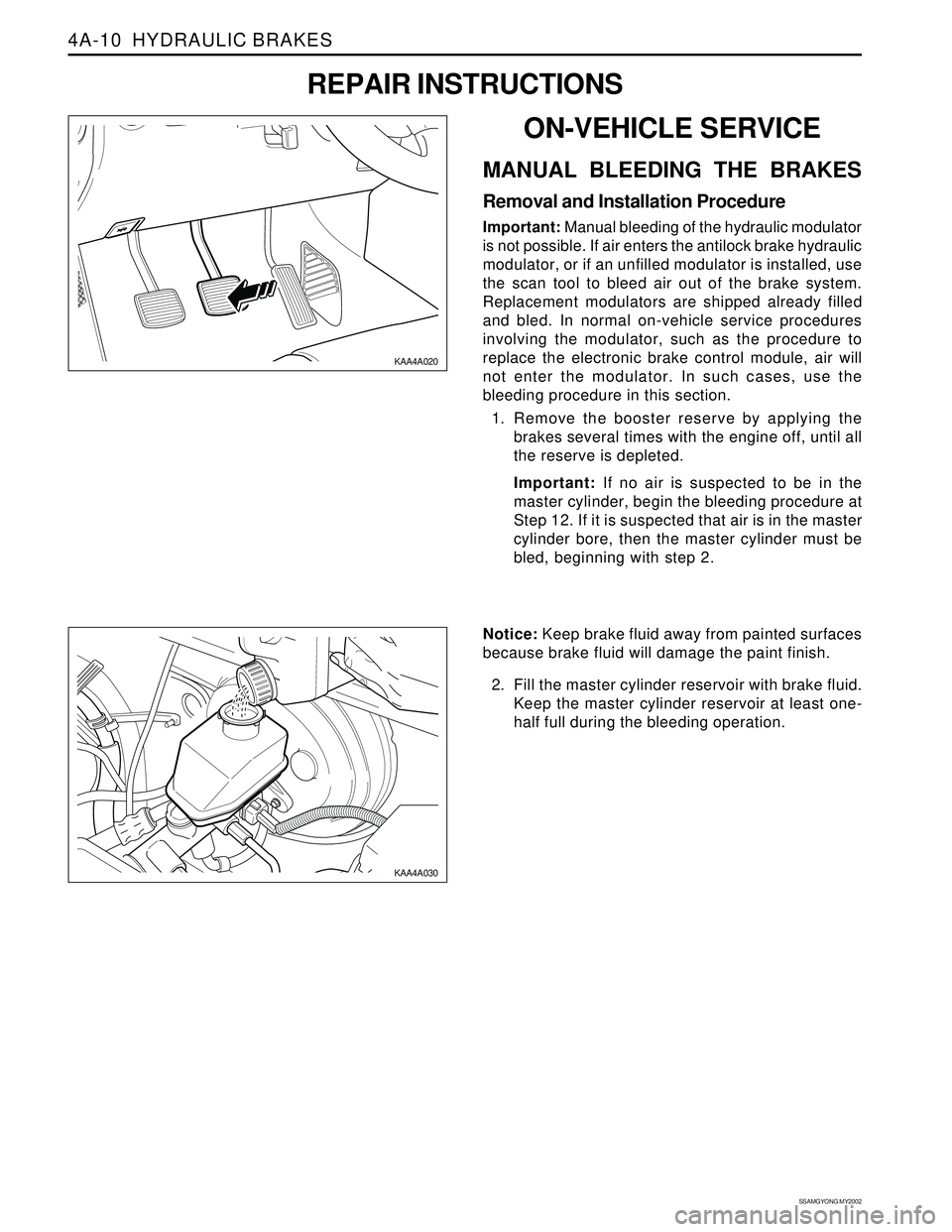
SSAMGYONG MY2002
4A-10 HYDRAULIC BRAKES
KAA4A020
KAA4A030
Notice: Keep brake fluid away from painted surfaces
because brake fluid will damage the paint finish.
2. Fill the master cylinder reservoir with brake fluid.
Keep the master cylinder reservoir at least one-
half full during the bleeding operation.
ON-VEHICLE SERVICE
MANUAL BLEEDING THE BRAKES
Removal and Installation Procedure
Important: Manual bleeding of the hydraulic modulator
is not possible. If air enters the antilock brake hydraulic
modulator, or if an unfilled modulator is installed, use
the scan tool to bleed air out of the brake system.
Replacement modulators are shipped already filled
and bled. In normal on-vehicle service procedures
involving the modulator, such as the procedure to
replace the electronic brake control module, air will
not enter the modulator. In such cases, use the
bleeding procedure in this section.
1. Remove the booster reserve by applying the
brakes several times with the engine off, until all
the reserve is depleted.
Important: If no air is suspected to be in the
master cylinder, begin the bleeding procedure at
Step 12. If it is suspected that air is in the master
cylinder bore, then the master cylinder must be
bled, beginning with step 2.
REPAIR INSTRUCTIONS